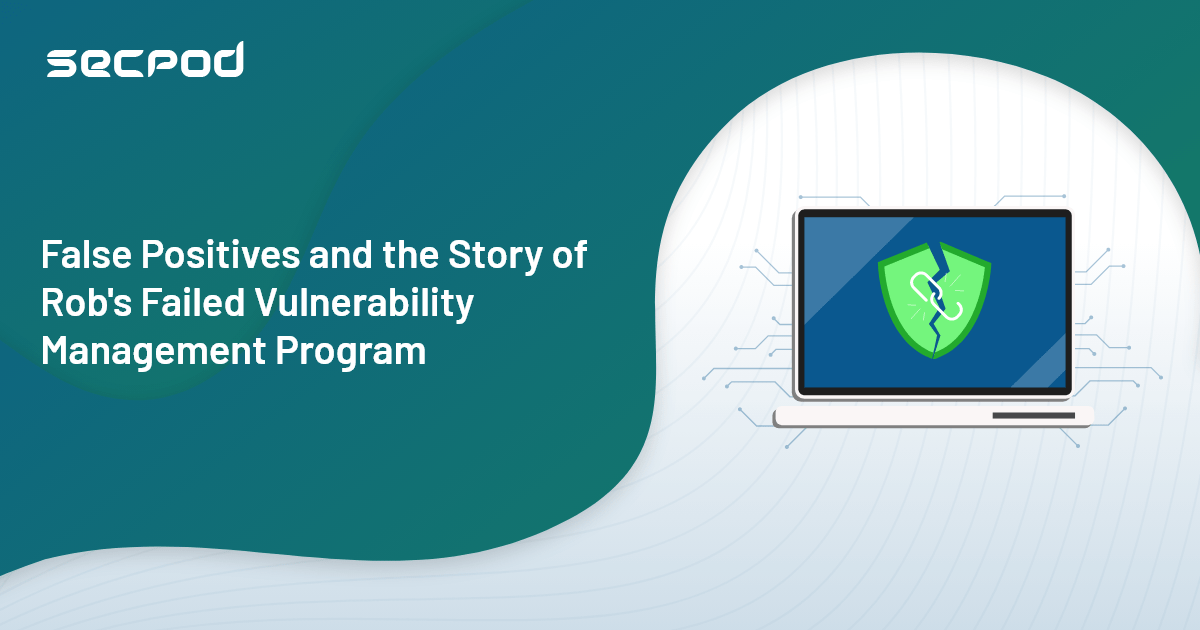Like most security admins, Rob is always on his toes to protect the digital infrastructure of his organization from bad actors. Rob, aka Robbie, that’s what his colleagues and employers used to call him, relied on a static vulnerability management program and went ahead with a 14-day free trial. For anyone to understand the core understanding of a vulnerability management program, 14 days seem enough, right? However, understanding the product from findings and reports can sometimes be deceiving.
Robbie’s heart skipped a beat when he put the automated scanning feature of modern-day vulnerability management into motion. Well, who wouldn’t? If a security admin can schedule scanning, discovering, and remediating, that makes their job a little stressful. Who would like to walk around like a lifeless corpse upon failing a security breach? However, little did Robbie know that his very first finding that he dedicated a week to, more or less, was nothing but a false positive. Once the false-positive report was out, the entire organization knew his hiccup.
False Positive’s:
Irrespective of whether false positives can be addressed or suppressed, Robbie understood that he’d hit rock bottom. Any vulnerability management to function at its optimum false positives should be avoided at all costs. Robbie had to draft an email explaining to the team that he’s hit a dead end as they thought they discovered a vulnerability that didn’t exist in the first place. Things began to go downhill when the false-positive began to create a torrent of loud noises, headspins, and unnecessary remediation.
As this was the first false-positive case that Robbie came across, he wanted to understand more about it. Robbie put his complete and utter trust in finding the ravaging wolf. As he cried at the top of his voice and made the village vigilant, they came to his rescue. The villagers could not encounter the wolf even with the torches, sickle, and pitchforks. When it comes to false positives, you cannot examine the false alarm; you have to explore all of them. Irrespective of hitting a dead end and with shackles around his legs due to finite resources, Robbie made up his mind to understand how this blunder came into being.
The Fundamental Difference between False Positive and False Negative
It wasn’t just a roadblock for Robbie anymore, and it’s about securing the digital infrastructure by any means necessary. Robbie found out that there are two conventional errors that security admins come across:
False Positive: Robbie’s scenario is the classic case of false-positive that suggests a vulnerability is found, but it’s not substantial. Further creates ruckus and noise and leads to remediation work that isn’t necessary. False-positive is the “Type I Error.”
False Negative: False-negative or “Type II Error” is equally demeaning as the positive counterpart. However, it is fatal for everyone in an organization as vulnerability scanning fails to identify a vulnerability lurking in the shadows.
What’s wrong with Rob’s Vulnerability Management Program?
Rob has a reputation for being “too careful” when protecting the digital infrastructure. Rob made sure that everything he did was a tad perfect, even in the past. However, even the best of us sometimes fall into the endless infernum of negligence. Rob put all of his faith in the new vulnerability scanner without researching its accuracy, vulnerability database, and other parameters that determine how successful the vulnerability scanner is.
This is a classic case of taking only the subset of information to determine if a vulnerability was determined or not. Rob, through his email, also provided ways by which one can reduce the case of false positives. For starters, Rob came up with a revelation that the scanner must comprise the necessary details. The scans would also require access to the information of all devices to determine the credibility of vulnerability.
1. The Curious Case of Sensitivity and Specificity in Measuring a VM’s Accuracy
Both sensitivities, as well as specificity, are parameters that Rob didn’t consider in the beginning. Here sensitivity is responsible for measuring the real positives upon scanning and discovery. At the same time, specificity measures negatives in real-time. Together, sensitivity and specificity eliminated the birth of false negatives and false positives.
Rob thought achieving 100 percent sensitivity and specificity could be deemed the perfect test. He even felt that the entire scenario of finding false positives is like a needle in a haystack.
2. Measuring Coverage and Accuracy in Vulnerability Management
Rob’s static vulnerability management has become quite obsolete in recent times. They lack cutting-edge accuracy, and conventional vulnerability management will not go through a massive paradigm shift in advancement over the years. Understanding the essence of vulnerability management tools, old and new, is inevitable to understand their strengths and weaknesses. Rob has been a security admin as far as he can remember. Even with all the exposure and knowledge about cybersecurity, he’s at times perplexed about the results concerning a VM.
Generally, hundreds of thousands of cases are systematically designed to measure the capabilities in a VM. A vulnerability management tool without a robust database made Rob unaware of the critical vulnerabilities that needed remediation.
How can False Alarms Prevent you from fixing up Vulnerabilities?
Using an old-school vulnerability scanner will provide you with conservative numbers of protecting devices. For instance, if your vulnerability scanner has recorded a false positive out of 40 vulnerabilities in a machine, you’d have to look at all the vulnerabilities manually. Even for someone as experienced as Rob, he’d at least take 10-15 mins to investigate each of these vulnerabilities.
Finding the true positives is essential as false alarms could lead you to the point of no return. Determining the flaws and the vulnerabilities that need fixing would require accurate vulnerability management. Else you’ll have to wear Rob’s shoes once or twice every month. Moreover, false alarms like these will make you look for vulnerabilities in the wrong place while your entire IT infrastructure would have been compromised.
Irrespective of this devastating case of false positives, Rob is one of the great security admins the organization has ever seen. The amalgamation between someone as gifted and expert in security alongside vulnerability management would eliminate the possibility of false positives. Rob is in dire need of continuous vulnerability management that is accurate in detecting vulnerabilities. Siding robust vulnerability management with a concrete plan would go a long way in protecting networks and devices in an IT infrastructure.
Rob usually takes a few extra steps to ensure that all the patches are installed to keep attackers at bay. He often heads monthly meetings to point out the importance of installing patches and updating OS and software upon the availability of a new version. A good vulnerability management program powered by a massive security database will take automation to a whole new level.
How to eliminate False Positives in your VM Program?
Today false positives are more common than you think. Almost all vulnerability management tools show false positives if the resources to detect vulnerabilities aren’t substantial. Like Rob, you should also begin hunting for a vulnerability management tool that leverages a great security intelligence feed. With a good vulnerability management database, the accuracy of finding vulnerabilities, even the hidden ones, becomes seamless. A vulnerability management program should help security admins like Rob to discover vulnerabilities and eliminate the inception of false positives; failing to do so would defecate the purpose of why the vulnerability management came into being in the first place. A good security intelligence feed is the bare minimum to make a VM work.
In addition to this, a vulnerability management program’s efficacy also plays a crucial role. After this scenario, Rob is fully aware of what he’s looking for in vulnerability management. It is advised not to be like Rob when hitting a dead end. Efficient vulnerability management should:
- Automate vulnerability scans every day. As attackers are relying on more sophisticated tools, scanning your IT infrastructure every day to find out vulnerability is the need of the hour.
- Vulnerability management integrated with patch management for complete 360-degree protection. Integrated patch management will aid you to remediate risks before they become a mammoth-like danger.
- A carefully curated vulnerability management tool will offer incredibly insightful reports which can also be customized. When reports are generated without the need for human input, it makes the work of a security admin less stressful. Additionally, security teams will procure reports on time, further making actionable plans a reality.
Achieving almost Zero False Positive with SanerNow’s Continuous Vulnerability Management
SecPod SanerNow Vulnerability Management is the result of over a decade of extensive security research and analyzing complex cyber threats. SecPod SanerNow leverages the home-grown vulnerability database SCAP Repository, also the world’s largest. The SCAP Repo comprises over 160,000 security checks, making it accurate and fast to scan vulnerabilities across 10,000 devices. Further, making SanerNow Vulnerability Management an absolute choice to overcome the challenge of zero false positives.
So, what are you waiting for? Make use of the free demo today to see SanerNow in action!


